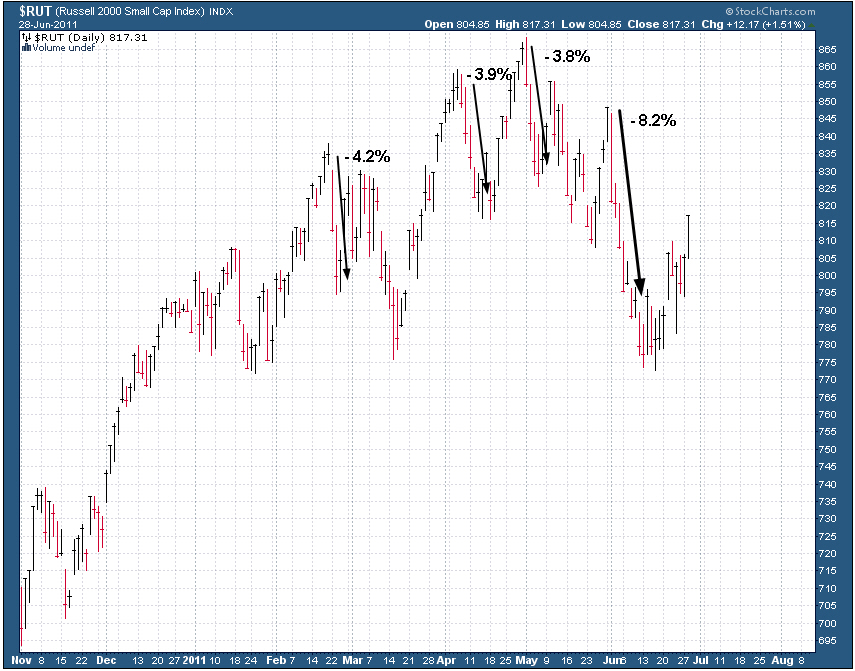 Author: Ben Dickey, BSG&L Financial Services LLC
Author: Ben Dickey, BSG&L Financial Services LLC
Covestor models: Pure Growth and Growth Plus Income
The first quarter of 2012 came in with fairly good growth, both in GDP and employment gains. However, the second quarter results so far have managed to stumble to 1.5% growth. We have now seen GDP output decline from 3% in the fourth quarter of last year to 1.9% in the first quarter of this year and now down to 1.5% growth in the second quarter.
In addition, employment gains have fallen to an average of 75,000 to 80,000 per month over the same timeframe. As a result, the unemployment rate is ticking back up. It now stands at 8.2%. This number is only valid if you do not count the hundreds of thousands of former wage earners that have quit looking for work.
Our economy is still being impacted by several factors, and the European debt troubles is one of them. The European situation had improved in the first quarter. However, the last couple of months has seen an about-face, with increased concerns with the viability of the Euro currency. In addition, Greece came close to leaving the Eurozone until the moderates prevailed in a very close election, allowing them to stay.
The yields on Spanish and Italian sovereign debt have risen to a point that indicates to me that the markets believe a bailout of these countries will be necessary. High debt levels in the remaining countries of the Eurozone continue to create investor fear and will likely slow their growth for the foreseeable future.
This is causing a flight of capital from these countries, which is compounding Europe’s troubles. One of the few bright spots is that Germany’s concessions at the last EU summit suggest they may be willing to compromise going forward in order to reach a workable solution.
Another important factor impacting the U.S. economy is the massive fiscal cliff Congress is facing at the end of the year. The expiration of the Bush-era tax cuts, the temporary reduction of the payroll tax cuts, and the extended level of unemployment benefits will expire on December 31st.
Compounding the problem is the “sequestration” of government spending from the failure of the Super Committee is also scheduled to take effect in January, 2013. As a result, market sentiment has turned extremely pessimistic. I do not believe that companies will have a much clearer understanding of the resolutions until after the election in November.
However, all is not doom and gloom with the U.S. economy. A byproduct of the weakening world economy is falling commodity prices, at least for the near term. Overall, even with all the negative effects, the economy continues to expand, albeit at a slower rate.
There are several market segments doing well. Major technological advances in the oil and gas industry have allowed the U.S. to increase its oil production for the first time in over twenty years. A large percentage of the employment gains in the U.S. have been in the oil and gas industry. The decrease in natural gas prices is lowering the cost to manufacturing companies.
Utilities, where they are able, are changing from coal to natural gas for electricity production. This should help lower utility costs, helping the U.S. economy. In addition, the increased production of natural gas liquids such as ethane, propane and butane has lowered the input costs for the chemical industry.
As a result, chemical companies are moving production back to the U. S. from overseas, which is causing plants in the Gulf Coast to expand capacity at a strong clip. New pipelines are under construction. The lower leg of the Keystone XL pipeline from Cushing OK to the Texas Gulf Coast has finally received the last approval. This should be finished by mid-2013.
The new pipelines will lower transportation cost from the Eagle Ford, Permian Basin and Marcellus shale’s to the gulf coast. The lower transportation cost provided by the new pipelines will make the U.S. chemical industry even more competitive. The Keystone will bring more U.S. crude to Gulf Coast refineries, allowing us to lower the amount of imported oil and allowing the refineries to improve their profits.
Throughout the world, emerging market economies have slowed, but still have a growth rate of mid to upper single digits. China and India have each doubled their economies over the last 10 years. As their economies become larger, it is almost impossible to keep up double digit growth.
However, an eight percent growth rate in their now trillion dollar economy is more output increase than the twelve percent growth rate that they had enjoyed over the past ten years. We agree with those economists who are predicting that the countries will be able to continue their high single digit economic growth rates.
We believe our equity markets have approached a very oversold condition. Fear has trumped fundamentals in the market. Oversold markets are like a tight rubber band. As fear subsides, the market is likely to snap back.
BSG&L has a long term horizon. These beliefs cause us to stay with an overweighting in our basic portfolio allocation to industrials in our Growth Portfolio. We like Caterpillar (CAT), Deere & Company (DE), Honeywell International (HON), United Technologies (UTX), Emerson Electric (EMR), and Cummins (CMI) in the industrial sector. We believe several of these stocks are dramatically oversold. As the market settles down we will add to our positions.
In the energy service sector we like Helmerich & Payne (HP), Cameron International (CAM), Halliburton (HAL), Mitcham Industries (MIND) and Schlumberger (SLB). Our commodities and energy holdings have changed very little. We continue to like Continental Resources (CLR), Anadarko Petroleum (APC) and EOG Resources (EOG) in energy.
In industrial commodities we like Peabody Energy (BTU), Freeport-McMoRan Copper & Gold (FCX), Cliffs Natural Resources (CLF), Vale S.A. (VALE), and Southern Copper (SCCO). Industrial commodity prices have seen a large pullback, bringing these companies’ share prices down.
Our belief is we should be building our cash position for now and let the markets settle down. I think we will be able to purchase these companies at good value prices before the end of the year for another good upward move.
As I stated earlier, fear has overcome fundamentals. The coal markets are a good example. To replace all the coal fired utilities in the U.S. with natural gas fired plants would require a capital investment of over $700 Billion. This is many times the market capitalization of all the utilities in the U.S. India has over 300 million people with no electricity and Japan is dramatically increasing coal purchases as they shut down their nuclear power plants.
Coal currently supplies over 40% of the electricity in the world and we believe that will only increase going forward. Also, studies show coal becomes competitive with natural gas in the $3.50 to $4.00 per million BTU’s.
As we have been saying for quite a few months now, the pipeline companies and commodity MLPs are experiencing tremendous growth, although their stock prices have been impacted by the drop in oil and natural gas prices.
We think this is an excellent time to add to these positions for the long term increases in stock price and distribution amounts that we think are coming. As a result, in our Growth and Income Portfolio we continue to add Kinder Morgan Energy Partners (KMP), Linn Energy (LINE), Enterprise Products Partners (EPD), SandRidge Mississippian Trust (SDT) and SeaDrill Limited (SDRL). These companies have strong dividend rates of between 6% and 10%.
We are light in the Technology sector, but like Amazon.com (AMZN), Apple (AAPL) and International Business Machines (IBM). We have recently added Broadcom (BRCM) and Qualcomm (QCOM) to our technology holding. Both are major suppliers to Apple for chips in mobile devices.
Just to restate, I believe the European debt problem and the upcoming U.S. elections have us concerned about market activity for the rest of this year. Hedging this volatility, in my opinion, will be hard. Gold last year was as volatile as the stock markets. I believe copper and oil will be the inflation hedges going forward. Otherwise, the only way to reduce volatility in your portfolio is to add some consumer staples with good dividend streams.
However, if you are a long term investor, the aforementioned sectors could prospectively allow an investor to outperform the markets with a somewhat reduced amount of volatility for the foreseeable future.



